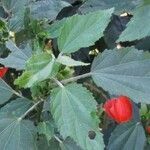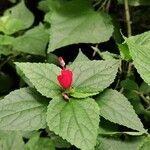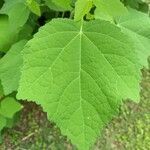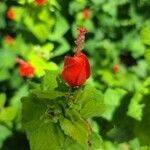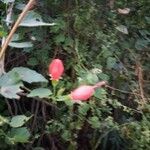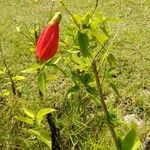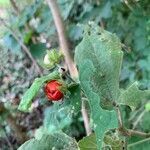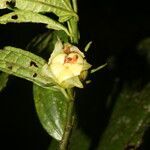Shrubs ca. 1 m tall. Branchlets sparsely villous to glabrate, rarely glabrous. Stipule filiform, ca. 4 mm, usually caducous; petiole 2-5 cm, puberulent; leaf blade broadly cordate to ovate-cordate, usually 3-lobed, sometimes entire, 6-12 × 2.5-10 cm, nearly glabrous or stellate pilose on both surfaces, basal veins 3 or 5, base broadly cuneate to nearly rounded or cordate, margin crenate, sometimes irregularly so, apex acuminate. Flowers solitary, axillary, pendulous, tube-shaped, slightly expanding only at top, 2.3-5 cm. Pedicel 3-15 mm, villous or puberulent. Epicalyx lobes spatulate, 8-15 mm, connate at base, hairy. Calyx campanulate, ca. 1 cm in diam., lobes 5, slightly longer or shorter than bracteoles, hirsute. Petals 5, scarlet-red, 2.5-5 cm. Staminal column 5-7 cm, exceeding corolla tube. Style branches 10. Ripe fruit bright red, usually 3-or 4-seeded.
Spreading shrub to 2-(3) m high, often spreading vegetatively by layering. Stems densely clothed in stellate hairs. Lvs densely clothed in stellate hairs, velvety to touch, ovate to suborbicular, cordate, acute to acuminate, not lobed or shallowly 3-lobed, crenate-serrate, c. 5-15 cm long; petioles c. 2-12 cm long; stipules lanceolate, 3-8 mm long, deciduous. Fls axillary, solitary or few in fascicles; pedicels 10-30 mm long; epicalyx segments 7-9, linear, united for lower ?-1/4, somewhat < or ± = calyx; calyx tubular, clothed in stellate hairs; calyx teeth ciliate, triangular, much < tube; petals scarlet, 20-35 mm long. Fr. fleshy, red, 1-3 cm diam.
Plants 0.5–3[–10] m. Leaf blades elliptic to broadly ovate, 4–20[–25] × 3–12 cm, surfaces sparsely to densely hairy with simple and stellate trichomes. Involucellar bractlets linear-spatulate. Flowers ascending or erect; calyx persistent, lobes connate for 1/2–2/3 their lengths, 8–15 mm, glabrous or hirsute; petals imbricate at anthesis, asymmetrically obovate-cuneate and auriculate toward base, 1.5–4(–5) cm; staminal column with 5 apical teeth; stigmas exserted. Fruits berrylike, usually red, not winged, 8–13[–16] × 10–17 mm, fleshy, edible; mericarps broadly ellipsoid wedge-shaped, smooth, glabrous. Seeds reniform, 3/4 as wide as long. 2n = 56.
A small shrub. It grows about 2-4 m high. The leaves are long or heart shaped and velvety. They are 5-12 cm long. The leaves can have 3 lobes. The flowers are long and tapering. They face upwards. The fruit are small red berries.
